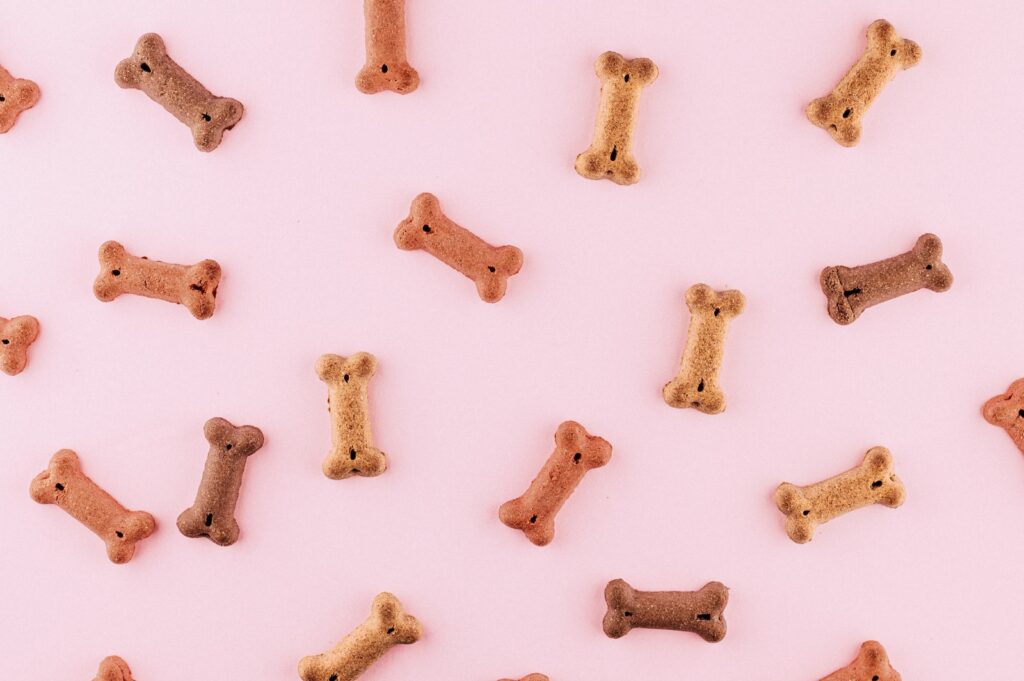Introduction
Welcome to the canine culinary universe! As a dog owner, you likely view treats as a tool for training or a way to shower your furry friend with love. But did you know there’s a whole science behind crafting the perfect treat? This article will be your guide to uncovering the untold truths about dog treats.
From decoding confusing package labels to understanding your dog’s unique nutritional needs, we’ll explore every aspect of the treat world. You’ll learn how to select wholesome ingredients for homemade goodies and how to use treats to strengthen your bond. We’ll even share innovative recipes to wow your pup’s palate.
By the end of this treat journey, you’ll have all the insider tips you need to become a canine treat connoisseur. Your dog’s taste buds will thank you! So let’s jump in and begin unveiling the hidden secrets of dog treats.

Chapter 1: Decoding Dog Treat Labels
When browsing the treat aisle, those tasty morsels beckon behind flashy packaging and clever names. But before tossing treats into your cart, it pays to scrutinize the ingredient list. Dog treat labels can conceal a lot under the surface.
The Mystery Behind Ingredient Lists
Treat labels highlight exciting components like bacon, peanut butter, and cheese, but these are often present in minuscule quantities. Products emphasize flavor over nutrition. And generic terms like “meat meal” don’t reveal the true meat source.
You may spot harmless-sounding additives like “natural flavor” without realizing these are highly processed compounds. It takes some detective work to parse treat ingredients and nutrition facts. But understanding labels leads to smarter selections.
Identifying Harmful Additives
Some common treat additives to avoid include propylene glycol, BHA, BHT, and ethoxyquin – all preservatives linked to organ issues and cancer. Artificial colors like Red 40 and Yellow 5 provide no nutritional value and may cause allergic reactions.
Added sugars and salt increase flavor at the cost of your dog’s health. And unnamed fats like “animal fat” could come from unhealthy sources you’d rather avoid. Knowing how to spot red flags empowers you to reject toxic treats.
What “Natural” Really Means
Don’t be swayed by buzzwords like “natural.” This term is unregulated, so manufacturers exploit it freely. A treat with images of whole foods on the package may contain very few of those ingredients. And something “naturally flavored” can have artificial flavor compounds.
Scrutinize health claims as well. A “grain-free” treat with potatoes and legumes won’t necessarily be lower carb. And one marketed for dental health may contain minimal plaque-fighting ingredients. Read critically rather than trusting clever marketing.
Want to make sure you start best dog care as early as possible? Check out our guide on Puppy Training Secrets!
Chapter 2: Homemade vs. Store-Bought Treats
When deciding how to supply your dog with treats, two main options exist: homemade creations or store-bought selections. What are the relative pros and cons of each? Let’s break it down.
The Pros and Cons of Homemade Delights
Homemade treats allow for total control over ingredients. You can select premium components like grass-fed meats, organic produce, and superfoods. DIY treats also minimize additives. Plus, prep engages your dog through aromatic kitchen aromas.
Downsides are prep time and costs. Sourcing high-quality ingredients takes effort and money. Storage can be problematic as well. And achieving complete nutritional balance requires vigilance. Still, homemade treats provide unparalleled quality and customization.
Analyzing Commercial Treats: What to Watch Out For
The convenience of grabbing a pack off the shelf makes store-bought treats an easy choice. Wide variety accommodates preferences and restrictions too. Portability and longer shelf life are also perks.
But mass production introduces more variables you can’t control. How are ingredients sourced and processed? What’s the manufacturing hygiene like? And are formulas created by pet nutrition experts? Try to verify sourcing, oversight, and quality for commercial treats.
Ultimately, a mix of homemade and quality-verified store-bought treats can optimize nutrition, cost, and convenience. Just emphasize ingredients over branding when choosing pre-made treats.
Chapter 3: Tailoring Treats to Your Dog’s Needs
While all dogs love treats, not all treats are suited for all dogs. Certain factors determine which treats nourish rather than endanger your hound. Here are some ways to tailor treats to your dog.
Breed-Specific Treats
Some physical and dispositional traits vary across dog breeds, requiring breed-specific nutrition. Smaller breeds tend to have faster metabolisms and need more calories concentrated in smaller treats. Giant breeds have higher joint stress and benefit from treats with glucosamine.
Herding dogs need more fats and proteins to fuel their energy. And calming treats help naturally excitable breeds relax. Consider your dog’s breed when selecting treat composition.

Age-Appropriate Treats
Growing puppies and senior dogs have different nutritional requirements. Puppies need treats with more calcium for bone development and DHA for brain growth. Avoid excess Vitamin A which can cause skeletal issues.
Seniors benefit from lower calorie, lower sugar treats to avoid weight gain. Including omega fatty acids and glucosamine support aging joints. And limiting sodium protects the hearts and kidneys of older canines. Choose treats aligned with your dog’s life stage.
Health-Based Treats
If your dog has a particular health issue, target treats to those needs. For dental problems, pick treats that mechanically scrub teeth. Digestive issues call for gentle, limited ingredient treats. For shedders, fatty acids and Vitamin E improve coat health.
Dogs with food sensitivities require hypoallergenic treats free of triggers. And active dogs need high protein, energizing treats. Let your dog’s health priorities guide your treat selections.
Speaking of health check out our Secret Dog To Dog Grooming Here!
Chapter 4: Wholesome Ingredients for Homemade Treats
Whipping up homemade treats lets you control what goes into them. But with so many potential ingredients, where do you begin? Here are wholesome, nutritious options perfect for DIY doggie delicacies.
Nutrient-Rich Options for DIY Treats
For protein, select single-source meats like chicken, turkey, beef, or fish. Some great produce picks are sweet potatoes, carrots, apples, and bananas. Oats, flaxseed, peanut butter, and Greek yogurt also pack a nutritional punch.
Consider trendy superfoods like chia seeds, kale, and blueberries too. And don’t forget hydrating, flavorful additions like broth, honey, and eggs. Combining a few of these wholesome ingredients makes perfect DIY treats!
Kitchen Safety Tips
When baking treats at home, be mindful of kitchen safety. Avoid sharing utensils with human food prep. Prevent contamination by thoroughly cleaning surfaces, bowls, and tools. Use separate oven trays for dog treats if possible.
Properly store treats in sealed containers and refrigerate or freeze perishable ones. And consult your vet about any novel ingredients that could be problematic for your dog. With some care and pre-planning, your kitchen can become the perfect treat laboratory.
Chapter 5: The Science of Positive Reinforcement
For many owners, treats fuel training and reinforce good behavior. But giving treats effectively requires understanding how they influence canine brains. Here’s what science says about positive reinforcement.
How Treats Affect Behavior
Treats stimulate dopamine production which makes dogs feel happy and rewarded. Repeated treat association with a particular behavior encourages repetition by your dog. Treat timing is critical – delivery should occur immediately following the desired response.
This conditions the behavior through positive association. Random or late treats lose effectiveness. Consistency, repetition, and proper timing ensure your dog connects treats with the right behaviors.
The Dos and Don’ts of Treat Training
When using treats for training, deliver small, pea-sized rewards so your dog doesn’t get full. Mix up high and lower value treats to maintain motivation. And don’t overdo treats – you want sincere behavior, not bribery.
Introduce new commands separately from old ones to avoid confusion. Remember treats are a supplement to praise, not a substitute. And end every session on a good note with a simple, successful command. Follow these tips for informed, ethical treat training.
Chapter 6: Innovative Treat Recipes for Health and Happiness
Treat time doesn’t have to be boring. With the right recipes, you can whip up fun, drool-worthy treats that also support your dog’s health. Get ready to unleash your inner Chef Rover!
Brain-Boosting Treats for Mental Stimulation
Whip up treats that make your dog work for their reward. Hide kibble in a Wobbler toy or DIY puzzle box. Stuff a Kong with peanut butter or pumpkin and freeze it for a long-lasting challenge.
You can also turn training into brain games, rewarding correct responses with treats. Mentally stimulating treats prevent boredom and behavioral issues.
Teeth-Cleaning Treats for Dental Health
Scrub your dog’s pearly whites with specially formulated dental treats. Look for abrasive textures and plaque-fighting ingredients like chlorhexidine, zinc sulfate, and enzymes. Treats that force chewing deliver maximum dental benefits too.
You can even make tooth-friendly treats at home with hard veggies, ground chicken bones, or freeze-dried liver bits. Just be sure to avoid excess vitamin A from liver. Your dog’s dazzling smile will return in no time!
Low-Calorie Options for Weight Control
If your pooch is pudgy, keep the treats coming with healthier, lower calorie options. Try light versions from brands like Greenies or Milk Bone. Vegetables like carrots and cucumber slices have a low caloric density.
For homemade treats, replace some meat with veggies, swap fattier meats for leaner ones like turkey or fish, and avoid sugary add-ins. Smaller or thinly sliced treats can restrict calorie intake as well. Get all the joy of treats without expanding your dog’s waistline.
Chapter 7: Allergies and Dietary Restrictions
Does your dog suffer from food allergies or intolerances? Don’t despair – you can still include treats safely. Here are tips for catering to dietary restrictions.
Identifying Allergic Reactions
Typical food allergy symptoms in dogs include itchy skin, ear infections, digestive upset, and hot spots. An elimination diet can help pinpoint triggers. Common culprits are meat proteins, dairy, and grains.
Intolerances differ from allergies. Lactose and gluten sensitivity cause similar issues without immune involvement. Working with your vet helps diagnose sensitivities accurately. Don’t assume – always test.
Catering to Special Diets
For dogs with allergies, choose treats with novel proteins like bison, duck, or venison that reduce risk of reactions. Restricted ingredient treats also prevent exposures.
Many brands offer treats tailored for sensitivities, but check labels carefully. For food intolerances like gluten or lactose, verify treats are fully free of those components. With extra care, even dogs with restrictions can partake in treat time.
Chapter 8: The Shelf Life of Dog Treats
Whether homemade or store-bought, dog treats won’t last forever. How long do treats stay fresh and tasty? And when is it time to toss them? Understanding treat shelf life prevents waste (and upset doggy tummies).
How to Store Treats Safely
First, check package dates and storage guidelines. Most store-bought treats last around 6 months from manufacturing if sealed properly. Keeping treats in original airtight packaging is ideal for maintaining freshness.
Transferring to resealable bags or airtight containers adds an extra preservation boost. Store containers in a cool, dry spot away from sunlight and humidity. Refrigeration can prolong homemade treat shelf life too.
Recognizing Spoiled Treats
Check treats for visible mold, off-odors, texture changes, or rancid smells. Discard anything questionable. Hard or crunchy treats that soften and chewy treats that harden are past prime.
Treats with visible moisture or dried out, shriveled appearances should get tossed as well. And if your dog suddenly rejects a previously beloved treat, spoilage may be the reason. When in doubt, throw it out to stay safe.
Dog your Dog have stinky breath? Check here for our Secret Guide to Better Dog Breath

Chapter 9: Ethical and Sustainable Choices
Today’s consumers prioritize ethical and eco-friendly purchasing. Treat makers are responding with innovative sustainability initiatives and production transparency. Seek out these conscientious companies.
Environmentally Friendly Treats
Some makers like Planet Dog and Zuke’s utilize solar facilities and eco-friendly manufacturing materials. Others use recycled packaging and partner with environmental groups.
Purchasing locally-sourced, small batch treats from farmers markets and artisans reduces environmental impact as well. It feels good to choose treats leaving a lighter footprint.
Supporting Responsible Brands
Many top treat brands engage in public outreach, rescue partnerships and other social good efforts. Some donate a portion of profits to animal charities or provide employment opportunities for underserved groups.
Seeking out cruelty-free, socially-conscious treat makers allows you to use your dollars in meaningful ways. And reaching out provides helpful consumer feedback too.
Chapter 10: Beyond the Treat – Building a Bond
While tasty, treats serve a higher purpose – strengthening the bond between you and your furry best friend. Keep this goal top of mind during treat time.
Strengthening Your Connection Through Treats
Rather than simply handing treats over, use delivery as a chance for brief training and affection. Ask for a trick or command first, then provide the reward while praising your dog and offering gentle pets.
Turn treat time into a ritual of care and closeness. And match treats to your dog’s favorite activities – a snack after a walk, a bone while chewing time, a food puzzle when you leave. Soon treats become symbols of your special relationship.
Alternate Ways to Reward Your Furry Friend
While treats are great motivators, don’t overlook other ways to show your dog some love. Extra playtime, a new toy, letting your dog up on the couch to snuggle, or even just your undivided attention can also be powerful rewards.
Too many treats could lead to obesity, training that relies on bribery, or picky behaviors. Keep your dog delighted with a wide range of rewards for good behavior, not just edible ones.
Conclusion
Our journey through the hidden world of dog treats has equipped you with insider knowledge about canine cuisine. You now can identify quality treats and ingredients, store and serve them properly, and use them to enrich your dog’s life.
Treats are far more than just tasty snacks. They help train, bond, reinforce, occupy, clean, soothe, and fulfill essential nutritional needs. With your new expertise, you can unleash the full potential of treats to improve your dog’s health and highlight the special role they play in your life.
Now those confusing treat labels, dilemmas over homemade vs. store-bought, and deciding which treats suit your dog best have clear answers. As your dog’s needs evolve, you have the framework to adjust treats accordingly. Welcome to treat enlightenment!
Frequently Asked Questions (FAQs)
Answers to Your Burning Questions
What human foods can be used as dog treats?
Some human foods make healthy, pet-safe treats, like small pieces of cooked meat, eggs, cheese, peanut butter, oatmeal, plain yogurt, apples, carrots, and bananas. Avoid onions, chocolate, grapes, raisins, macadamia nuts, garlic, and excessive salt or sugar.
How many treats should a dog get daily?
Consult your vet, but general treat guidelines are: 1-2 treats per day for small dogs, 2-3 for medium dogs, and 3-5 for large dogs. Adjust amounts based on calories and whether you use treats for training. Homemade treats may require more calorie monitoring.
When should treats be given – during or after meals?
After is best, so treats don’t decrease appetite for normal food. Use small pre-meal treats just for training, not free feeding. Treats are tastier on an empty stomach too!
Is it okay to give a dog treats made for humans?
Some human snack foods like plain popcorn, potato chips, and pretzels are fine in moderation. But many contain unhealthy ingredients or sweeteners that dogs shouldn’t consume. Check labels and calorie content carefully before sharing human treats. When in doubt, avoid.
Are all natural treats really better?
Not necessarily. “Natural” is an unregulated term, so brands exploit it for marketing. Even ice cream can be “natural.” Check specific ingredients rather than assuming natural equals healthy. Homemade treats give you full control over ingredients.
How do I make treats more mentally stimulating?
Increase mental challenge by hiding treats around the house for your dog to find, putting treats in puzzle toys like Kongs, or making your dog practice commands before rewarding with treats during training sessions. Use treats to both physically and mentally enrich your dog!
Want to take your Dog Treat to the next level? Want to quit your job and make dogs happy for a living? Make more money making dog treats then you though possible, see step by step get a piece of the million dollar industry by clicking here


